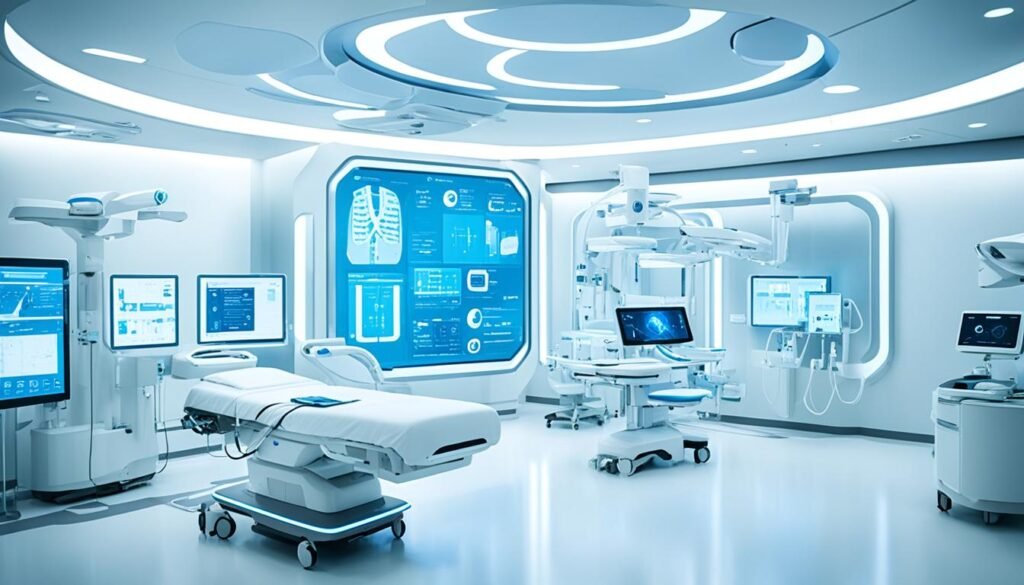Technology has revolutionized the healthcare industry, bringing about significant advancements in modern hospitals. From streamlining operations to enhancing patient care and safety, the integration of technology has improved healthcare outcomes across the board. As healthcare providers embrace technology in their practices, patient-centric approaches and innovative solutions are reshaping the delivery of care.
The use of technology in healthcare has not only reduced errors but also increased the overall quality of care. Government agencies such as the Safety Assurance Factors for EHR Resilience (SAFER) guides have been instrumental in helping healthcare organizations effectively integrate technology into their systems.
One area of focus in improving patient care is the implementation of clinical decision support (CDS) tools and computerized patient order entry (CPOE) systems. These tools provide healthcare professionals with patient-specific information, enabling them to make more informed decisions and reducing the risk of errors. However, the usability of these systems is crucial to ensure that healthcare professionals can effectively utilize them without increasing their burden.
In this article, we will explore the role of technology in modern hospitals and its impact on patient care. We will discuss the benefits and challenges of clinical decision support tools, computerized patient order entry systems, as well as the future of technology in healthcare.
Key Takeaways : Technology In Modern Hospitals
- Technology has significantly improved patient care and safety in modern hospitals.
- Clinical decision support tools and CPOE systems are crucial for enhancing patient care.
- Usability of technology systems is vital to ensure effective implementation.
- Alert fatigue and workflow integration are challenges in clinical decision support systems.
- The future of technology in modern hospitals holds immense potential for further advancements in healthcare delivery.
The Impact of Clinical Decision Support (CDS) Tools on Patient Care
Clinical decision support (CDS) tools are essential in modern healthcare settings, providing clinicians, patients, and other individuals with relevant and filtered data to enhance care quality. These tools deliver patient-specific information through various formats and channels, supporting healthcare professionals in making well-informed decisions.
Research has consistently shown that the implementation of CDS tools has a positive impact on patient safety and care enhancement. By improving the accuracy of medication orders and reducing duplicate orders, CDS tools contribute to the prevention of errors and adverse events. Automation of manual processes further streamlines healthcare workflows, enabling healthcare professionals to deliver efficient and effective care.
However, the successful utilization of CDS systems relies on their usability. User-friendly CDS tools that integrate seamlessly into existing workflows can optimize their adoption and impact on patient care.
“CDS tools have revolutionized the way clinicians access and utilize patient-specific information, improving the accuracy and efficiency of clinical decision-making.” – Dr. Rebecca Johnson, Chief Medical Officer at XYZ Hospital.
To illustrate the impact of CDS tools on care enhancement and patient safety, consider the following benefits:
| Benefits of CDS Tools | Details |
|---|---|
| Improved Medication Safety | CDS tools provide real-time alerts and reminders for potential drug interactions, dosage errors, and allergies, reducing the risk of medication errors. |
| Enhanced Diagnosis Support | CDS systems assist healthcare professionals in selecting appropriate diagnostic tests, interpreting results, and identifying potential diagnoses more accurately. |
| Guidance for Evidence-Based Care | CDS tools integrate clinical guidelines, best practices, and research-based recommendations, helping clinicians provide evidence-based care, resulting in improved patient outcomes. |
| Personalized Treatment Plans | By providing patient-specific information, CDS tools support the development of tailored treatment plans that consider individual needs and characteristics. |
As the healthcare industry continues to embrace technological advancements, the seamless integration of CDS tools into clinical workflows will be imperative. Healthcare organizations must prioritize usability considerations, ensuring that CDS systems are intuitive, efficient, and user-friendly. By optimizing the utilization of CDS tools, healthcare professionals can further enhance patient care, improve outcomes, and promote patient safety.
The Role of Computerized Patient Order Entry (CPOE) Systems in Streamlining Processes
Computerized patient order entry (CPOE) systems play a crucial role in improving patient safety and reducing medication errors. Studies have shown that a significant number of errors occur during the ordering or prescribing stage, making it essential to implement effective order entry systems.
CPOE systems have the potential to eliminate errors caused by illegible handwriting or manual copy errors commonly associated with paper-based order entry. By providing a digital platform for healthcare professionals to enter medication orders, CPOE systems enhance accuracy and reduce the risk of errors caused by misinterpretation.
Furthermore, well-implemented CPOE systems have demonstrated their effectiveness in reducing specific prescribing and procedural errors. By automating certain processes, such as medication dosing calculations and interactions with patient-specific information, these systems improve the overall quality of patient care. Automatic deprescribing of medication orders and seamless communication of relevant information to pharmacies have also shown significant improvements in patient safety and care outcomes.
However, it is crucial to address technological issues that may arise with CPOE systems. For instance, alert fatigue and the override of alerts pose challenges in maintaining the effectiveness of these systems. Striking the right balance in alert design and implementing robust automation protocols is necessary to ensure that alerts provide valuable information without overwhelming healthcare professionals.
| CPOE System Benefits | CPOE System Challenges |
|---|---|
| Reduces medication errors | Alert fatigue |
| Improves accuracy of medication orders | Alert override rates |
| Automates processes to prevent errors | Technological issues |
Preventing Medication Errors with CPOE Systems
“Implementing computerized patient order entry systems helps hospitals reduce medication errors and improve patient safety by eliminating errors associated with illegible handwriting or manual copy errors.”
To ensure the effectiveness of CPOE systems in preventing errors, healthcare organizations must address these technological challenges while continuously monitoring and refining their implementation. By leveraging the capabilities of CPOE systems and addressing potential issues, healthcare professionals can streamline processes, enhance patient safety, and deliver high-quality care.
The image below demonstrates the streamlined process enabled by CPOE systems:

As the healthcare industry continues to embrace digital transformation, CPOE systems will play a crucial role in optimizing processes and improving patient outcomes. With their ability to reduce medication errors and enhance patient safety, CPOE systems are essential tools for modern hospitals in streamlining processes and ensuring the effective delivery of care.
Usability Challenges and Considerations in Clinical Decision Support (CDS) Systems
When it comes to clinical decision support (CDS) systems, usability is key to their effective implementation and utilization by healthcare professionals. Poorly designed systems that do not align with existing workflows can lead to frustration and potential errors. To ensure successful implementation, it is crucial to consider end user needs and preferences when designing CDS systems.
Research has highlighted the challenges that arise when attempting to change clinicians’ existing workflows without increasing their burden. Understanding their workflow integration requirements and incorporating their feedback is essential to promote adoption and enhance system usability. Qualitative data and user feedback can provide valuable insights into improving system design and addressing end user needs.
Attention to detail in factors such as color scales, location, and types of data displayed in CDS dashboards can significantly enhance their usability. By optimizing the display and organization of information, healthcare professionals can easily access and interpret critical data, leading to improved decision-making and patient care.
The recent market consolidation in Electronic Health Record (EHR) vendors may impact the integration of user feedback into CDS systems. It is essential for healthcare organizations and technology providers to prioritize end user perspectives during system design and development.
Addressing usability challenges in CDS systems is crucial to prevent alert fatigue, a common issue faced by healthcare professionals. By striking the right balance between providing informative alerts and avoiding excessive noise, CDS systems can effectively support clinical decision-making without overwhelming clinicians.
Further research is needed to explore and identify innovative solutions to improve CDS systems’ usability, workflow integration, and end user satisfaction. By addressing these challenges, healthcare organizations can ensure the successful implementation and utilization of CDS systems, ultimately enhancing patient care and safety.
The Role of Alerts and Alarms in Clinical Decision Support (CDS) Systems
Alerts and alarms are crucial components of clinical decision support (CDS) systems that provide important and timely information to clinicians during the treatment process. These alerts serve as valuable reminders and notifications to help healthcare professionals make informed decisions and take appropriate actions.
Clinician response to CDS alerts plays a significant role in patient care and overall treatment outcomes. Studies have examined alert override rates, which depict the frequency at which clinicians override or disregard alerts. It is important to find a balance between alert sensitivity and specificity to ensure that alerts provide meaningful and relevant information without overwhelming healthcare professionals.
High alert override rates do not necessarily indicate ineffective CDS systems. Many alerts are appropriately overridden due to various factors such as patient-specific considerations, clinical judgment, and contextual information. The ability to customize alerts and establish appropriate thresholds is essential to achieve optimal alert utilization.
Preventing Alert Fatigue
Alert fatigue is a prevalent concern in healthcare settings due to the excessive number of alerts that clinicians receive. When clinicians encounter an overwhelming number of alerts, it can lead to desensitization and the tendency to dismiss or ignore critical alerts, putting patient safety at risk.
It is vital to design CDS systems in a way that minimizes alert fatigue and maximizes the impact of alerts on patient care.
To prevent alert fatigue, healthcare organizations should prioritize and refine their alert systems. This involves regular review and evaluation of alerts to ensure that they are evidence-based, clinically relevant, actionable, and aligned with best practices. Organizations can also consider implementing configurable and context-aware alert systems that take into account patient characteristics, healthcare provider preferences, and localized clinical guidelines.
Enhancing Alert Utility and Effectiveness
To improve the utility and effectiveness of alerts, it is essential to understand the underlying criteria for alert systems. This includes considering the type of information provided, the timing and frequency of alerts, and the potential impact on clinical decision-making.
Alerts should be designed to foster indicated clinical action while minimizing disruptions to workflow. They should provide concise and specific information that is easy to interpret and act upon. The appearance and formatting of alerts should be carefully considered to ensure they stand out and capture the attention of healthcare professionals.
| Key Considerations for Designing Effective Alerts |
|---|
| Alert specificity |
| Relevance to the individual patient’s condition |
| Integration with clinical workflow |
| Clear and actionable recommendations |
| Timely delivery of alerts |
| Appropriate thresholds for triggering alerts |
Regular evaluation and feedback from healthcare professionals are essential for fine-tuning alert systems. This iterative process can help identify areas for improvement and ensure that alerts continue to provide value in the clinical decision-making process.

In conclusion, alerts and alarms in clinical decision support (CDS) systems play a critical role in providing timely and relevant information to clinicians. Striking a balance between alert specificity and clinician response is essential to prevent alert fatigue and ensure the effectiveness of CDS systems. By continuously refining alert systems and considering key design considerations, healthcare organizations can optimize the utility and impact of alerts, leading to improved patient care and outcomes.
The Impact of Health Monitoring and Wearable Technology in Modern Hospitals
Health monitoring and wearable technology have become increasingly prevalent in modern hospitals. These technologies enable healthcare professionals to monitor patients’ vital signs and collect valuable health data continuously. Wearable devices, such as smartwatches and fitness trackers, can help in the early detection of health issues, monitor chronic conditions, and improve the overall patient experience.
One significant benefit of health monitoring and wearable technology is the ability to track patients’ vital signs in real-time. These devices provide continuous data on heart rate, blood pressure, oxygen levels, and more, allowing healthcare providers to detect any abnormalities promptly. The real-time monitoring capabilities enable early intervention and timely medical assistance, potentially preventing adverse health events.
“Wearable technology enables healthcare professionals to have a comprehensive view of patients’ health status, which aids in making accurate diagnoses and designing personalized treatment plans.”
In addition to monitoring vital signs, wearable technology also plays a crucial role in managing chronic conditions. Patients with conditions like diabetes, cardiovascular diseases, and respiratory disorders can use smart devices to track their symptoms, medication adherence, and physical activity. This data can be shared with healthcare professionals to ensure effective management of these conditions and prompt adjustments to treatment plans if necessary.
It’s important to note that while health monitoring and wearable technology offer numerous benefits, patient data security must be a top priority. The integration of wearable devices into healthcare systems requires robust data management protocols and cybersecurity measures to protect sensitive patient information. Healthcare providers must implement encryption, authentication, and access control measures to prevent unauthorized access or breaches.

Enhancing Patient Experience and Outcomes
Besides providing valuable health data, wearable technology improves the overall patient experience. Patients can actively engage in their healthcare by monitoring their own health, gaining insights into their well-being, and actively participating in their treatment plans. The convenience and accessibility of wearable devices empower patients to take charge of their health and promote a sense of autonomy and self-care.
Furthermore, wearable technology has the potential to reduce healthcare costs by minimizing hospital readmissions and emergency room visits. Continuous health monitoring enables early intervention and preventive care, reducing the likelihood of complications and the need for costly medical procedures.
Future Perspectives
The use of health monitoring and wearable technology in modern hospitals is continuously evolving. As technology continues to advance, these devices are expected to become more sophisticated, accurate, and user-friendly. Integration with artificial intelligence (AI) algorithms may enable wearable devices to provide more accurate interpretations and predictions based on collected data, further improving patient care.
The impact of health monitoring and wearable technology in modern hospitals is undeniable, offering advancements in patient care, proactive disease management, and enhanced patient experiences. As healthcare providers embrace these technologies and prioritize patient data security, the potential to revolutionize the way healthcare professionals diagnose, treat, and monitor patients becomes even more promising.
The Importance of Health Information Technology (HIT) in Hospital Operations
Health information technology (HIT) plays a crucial role in streamlining hospital operations and improving efficiency. With the integration of HIT systems, such as electronic health records (EHRs) and computerized physician order entry (CPOE) systems, healthcare professionals can access and manage patient information more effectively, leading to enhanced patient care and outcomes.
HIT systems eliminate the need for extensive paperwork and reduce duplication, allowing healthcare providers to focus more on patient care and less on administrative tasks. These systems also enhance communication and collaboration among healthcare professionals, facilitating a seamless exchange of information and improving coordination of care.
In addition to streamlining workflow, HIT systems contribute to significant cost reduction. By digitizing patient records and automating processes, hospitals can save resources and minimize the risk of errors caused by manual data entry or illegible handwriting. This not only improves operational efficiency but also enhances patient safety.
By leveraging health information technology, hospitals can achieve greater operational efficiency, reduce costs, and improve patient care.
Furthermore, the integration of HIT in hospital operations enables healthcare professionals to make data-driven decisions. The availability of real-time information and advanced analytics tools empowers clinicians to identify trends, monitor outcomes, and proactively address potential issues. This data-driven approach leads to better-informed decision-making and improved healthcare outcomes.
Overall, the implementation of health information technology in hospital operations is crucial for optimizing efficiency, reducing costs, and ultimately delivering high-quality patient care. The continued development and utilization of HIT systems will undoubtedly shape the future of healthcare by further enhancing operational processes and improving patient outcomes.
The Future of Technology in Modern Hospitals
The future of technology in modern hospitals holds immense potential for further advancements in healthcare delivery. As the healthcare industry continues to evolve, emerging trends such as artificial intelligence (AI) and the Internet of Things (IoT) are poised to revolutionize patient care and improve healthcare outcomes.
The integration of AI-powered technologies in hospitals enables healthcare professionals to leverage data-driven insights and enhance their decision-making process. AI can assist in diagnosing diseases, predicting treatment outcomes, and creating personalized treatment plans. By analyzing vast amounts of medical data, AI algorithms can identify patterns, detect early warning signs, and provide evidence-based recommendations for better patient care.
The IoT, on the other hand, allows for seamless connectivity and real-time data exchange between healthcare devices and systems. This technology enables remote patient monitoring, smart healthcare devices, and the integration of various healthcare systems, such as electronic health records (EHRs) and patient monitoring devices. Through IoT, healthcare professionals can access real-time patient data, streamline workflows, and provide proactive care.
The Impact of Artificial Intelligence in Healthcare
Artificial intelligence has the potential to revolutionize healthcare in multiple ways:
- Diagnostic support: AI algorithms can analyze medical imaging data, pathology reports, and patient records to assist in accurate disease diagnosis.
- Treatment optimization: AI can help healthcare professionals identify the most effective treatment options based on patient-specific characteristics and historical data.
- Predictive analytics: By leveraging machine learning algorithms, AI can predict patient outcomes, identify high-risk populations, and prevent adverse events.
- Personalized medicine: AI technologies can analyze genomic data and develop personalized treatment plans tailored to an individual’s genetic makeup and medical history.

The Role of IoT in Transforming Healthcare
The Internet of Things is reshaping healthcare by:
- Remote patient monitoring: IoT devices such as wearables, sensors, and home monitoring systems enable continuous monitoring of patient vital signs, allowing for early detection of health issues and proactive interventions.
- Smart healthcare devices: IoT-powered devices and applications provide patients with real-time health data, encourage healthy habits, and facilitate self-management of chronic conditions.
- Improved communication and collaboration: IoT enables seamless data integration between healthcare systems, improving communication and collaboration among healthcare professionals, patients, and caregivers.
- Enhanced healthcare accessibility: IoT technologies enable telehealth services, remote consultations, and virtual care programs, expanding access to quality healthcare, especially for rural and underserved populations.
The Future of Healthcare
The future of technology in modern hospitals is driven by continuous innovation and a focus on improving the overall quality of healthcare services. With the advancements in AI and IoT, healthcare professionals can deliver more precise diagnoses, personalized treatments, and proactive care. These technologies have the potential to enhance patient engagement, improve healthcare accessibility, and reduce healthcare costs.
As the healthcare industry embraces technology trends, it is crucial to address challenges such as data security and privacy, interoperability, and regulatory compliance. By overcoming these challenges and embracing the possibilities technology offers, modern hospitals can further enhance patient care and drive better healthcare outcomes.
The Impact of Technology on Patient Care and the Healthcare Industry
Technology has revolutionized the healthcare industry, transforming the way patient care is delivered. The integration of technology in healthcare processes has significantly improved patient safety, reduced errors, and enhanced the overall quality of healthcare outcomes. With the advent of advanced digital tools and systems, healthcare providers can streamline operations, automate tasks, and access real-time patient data, leading to more efficient and informed clinical decision-making.
One area where technology has made a significant impact is in patient safety. By leveraging technology, healthcare organizations have been able to implement robust systems for patient monitoring, ensuring timely intervention and reducing the risk of adverse events. Real-time monitoring of vital signs enables healthcare professionals to detect any abnormalities promptly and initiate appropriate care measures. This proactive approach enhances patient safety and improves healthcare outcomes.
Additionally, technology has revolutionized communication and collaboration among healthcare providers, leading to better coordination of care and improved patient outcomes. Electronic health records (EHRs) enable seamless sharing and access to patient information, ensuring that all members of the healthcare team are well-informed and can make well-coordinated decisions. This enhanced communication has proven to be instrumental in preventing medical errors, enhancing patient safety, and optimizing healthcare delivery.
“The seamless integration of technology in healthcare processes has streamlined operations, reduced errors, and enhanced the overall quality of healthcare outcomes.”
Moreover, technology has played a crucial role in expanding access to healthcare services through telemedicine and digital health solutions. Patients can now receive medical advice, consultations, and even treatment remotely, eliminating the barriers of distance and improving healthcare accessibility. This has particularly benefited patients in rural or underserved areas who may have limited access to healthcare facilities. By leveraging technology, healthcare providers can reach a broader patient population and deliver timely care, ultimately improving patient outcomes.
However, as technology continues to advance, it is vital to address the potential risks and challenges it may pose. Patient data security and privacy must be ensured to protect sensitive health information from unauthorized access or breaches. Healthcare organizations must implement robust cybersecurity measures and adhere to strict privacy regulations to maintain patient trust and confidence in digital healthcare solutions.

| Benefits of Technology in Patient Care | Impact on the Healthcare Industry |
|---|---|
| Improved patient safety through real-time monitoring and timely intervention | Streamlined operations and increased efficiency |
| Enhanced communication and collaboration among healthcare providers | Optimized healthcare delivery and resource allocation |
| Expanded access to healthcare services through telemedicine and digital health solutions | Promotion of innovation and technological advancements |
In conclusion, technology has had a profound impact on patient care and the healthcare industry. It has improved patient safety, streamlined operations, and enhanced healthcare outcomes. By leveraging technology, healthcare providers can deliver more efficient and effective care, expand access to healthcare services, and foster innovation in the field. As technology continues to evolve, it presents immense opportunities for further improvements in patient care and healthcare delivery.
Also Read : The Importance Of Mental Health Services In Hospitals – Breaking The Stigma
Conclusion
The role of technology in modern hospitals is vital, as it plays a significant role in improving patient care, streamlining operations, and enhancing healthcare outcomes. Technology, such as clinical decision support (CDS) tools and computerized patient order entry (CPOE) systems, has shown positive impacts on patient safety and care quality. The integration of health monitoring and wearable technology has revolutionized the way healthcare professionals diagnose, treat, and monitor patients.
As technology continues to advance, the future of healthcare holds immense potential. Emerging trends like artificial intelligence (AI) and the Internet of Things (IoT) are shaping the way healthcare is delivered. AI-powered technologies can assist in diagnosing diseases, predicting outcomes, and personalizing treatment plans. IoT devices enable real-time monitoring, remote patient care, and seamless data integration across healthcare systems.
To drive better healthcare outcomes, the healthcare industry must embrace these technological advancements. By leveraging technology, healthcare organizations can improve patient care, enhance healthcare delivery, and optimize resource allocation. The future of healthcare is driven by continuous innovation, with a focus on using technology to improve patient outcomes and overall healthcare quality.
FAQs
Q: How is technology revolutionizing the healthcare industry?
A: Technology is revolutionizing the healthcare industry by introducing new technologies, medical devices, and equipment that help improve patient care and outcomes.
Q: What is the role of smart technology in modern hospitals?
A: Smart technology is used in modern hospitals to create smart hospital environments that enhance patient care, streamline operations, and improve efficiency.
Q: How can technology like health monitoring technology benefit patients?
A: Health monitoring technology can help patients by providing real-time data on their health status, enabling early detection of medical conditions and personalized treatment plans.
Q: What are some technology trends in the future of healthcare?
A: Future healthcare will see advancements in healthcare technologies, healthcare data management, and the use of technology to empower patients to take an active role in their healthcare.
Q: How are technology companies contributing to the healthcare sector?
A: Technology companies are playing a significant role in the healthcare sector by developing innovative solutions to address healthcare needs, improve access to healthcare, and enhance patient outcomes.
Q: How is technology being used to improve healthcare data management?
A: Technology refers to healthcare data management systems that centralize and secure patient information, streamline processes, and facilitate data-driven decision-making for better patient care.
Q: In what ways can technology advances benefit medical staff in hospitals?
A: Technology advances can benefit medical staff by enhancing communication, optimizing workflows, facilitating remote consultations, and providing real-time access to patient data for informed decision-making.
Q: Can technology help in addressing traditional healthcare challenges?
A: Yes, technology like medical devices and equipment can help address traditional healthcare challenges by improving diagnostic accuracy, treatment efficacy, and overall patient care quality.
Q: What role does technology play in modern hospitals?
A: Technology in healthcare has revolutionized patient care by improving diagnosis, treatment, and overall quality of service.
Q: How is smart technology being used in hospitals?
A: Smart hospitals utilize advanced technology like health monitoring devices, data management systems, and medical equipment to enhance patient care and operational efficiency.
Q: How does technology help patients in the healthcare sector?
A: Technology like medical devices and healthcare data management systems helps patients access healthcare services easily and plays an active role in their healthcare.
Q: What are some future healthcare technology trends?
A: Future healthcare technologies may include advancements in technology for health monitoring, medical conditions diagnosis, and personalized treatment options.
Q: How is technology revolutionizing the healthcare sector?
A: Technology companies are continually developing innovative solutions to improve medical staff efficiency, enhance patient care, and meet the evolving healthcare needs of the population.
Q: What are the key benefits of using technology in modern hospitals?
A: Technology has a significant impact on improving healthcare outcomes, increasing patient safety, reducing medical errors, and enhancing overall quality of care provided by medical professionals.
Q: How can technology like medical equipment and devices improve patient care?
A: Technology advances in medical equipment and devices enable healthcare providers to diagnose and treat medical conditions more accurately, leading to better patient outcomes and improved quality of life.
Source Links
- https://psnet.ahrq.gov/perspective/technology-tool-improving-patient-safety
- https://www.ncbi.nlm.nih.gov/pmc/articles/PMC9601636/
- https://www.ncbi.nlm.nih.gov/pmc/articles/PMC7557885/




